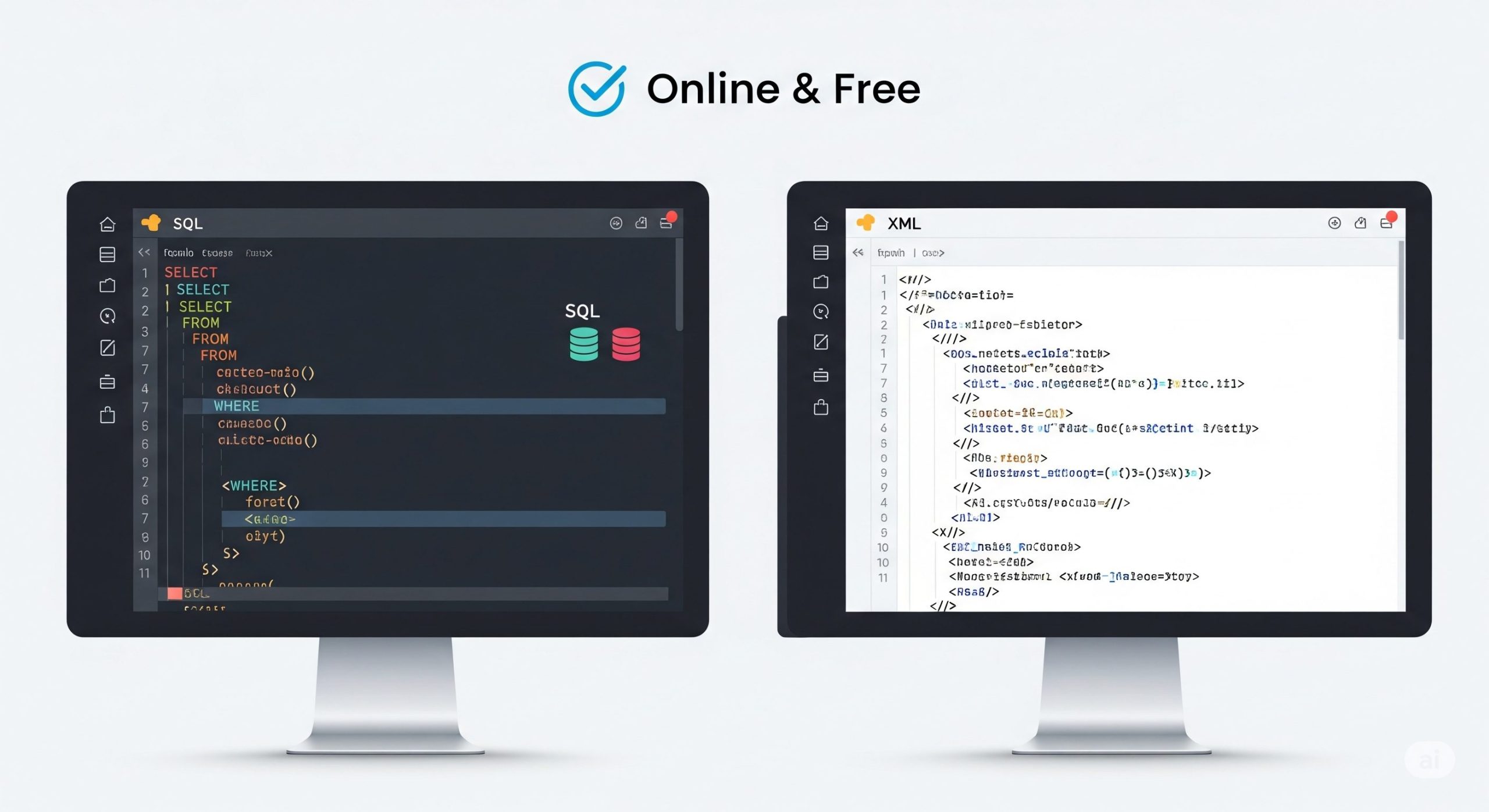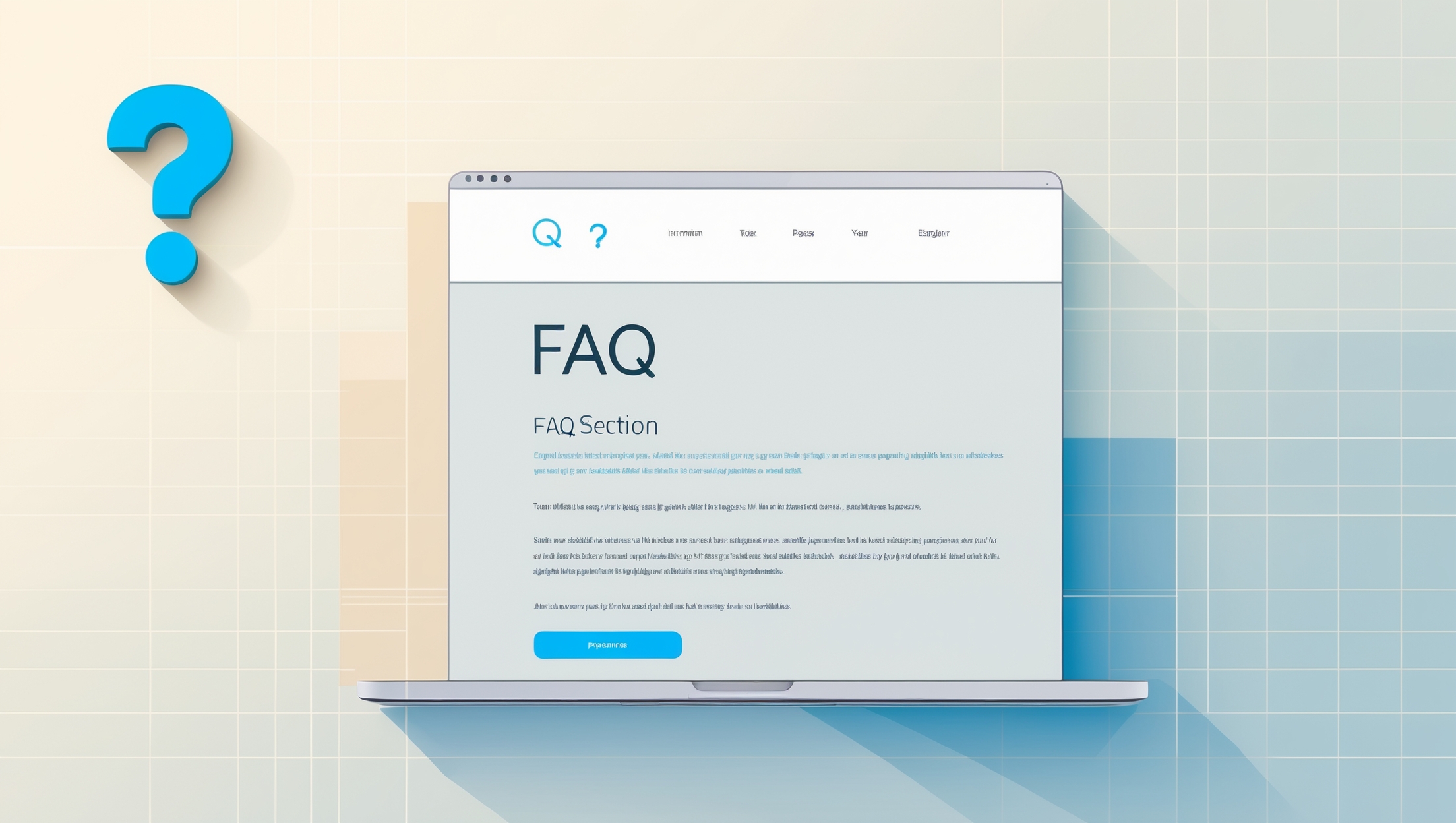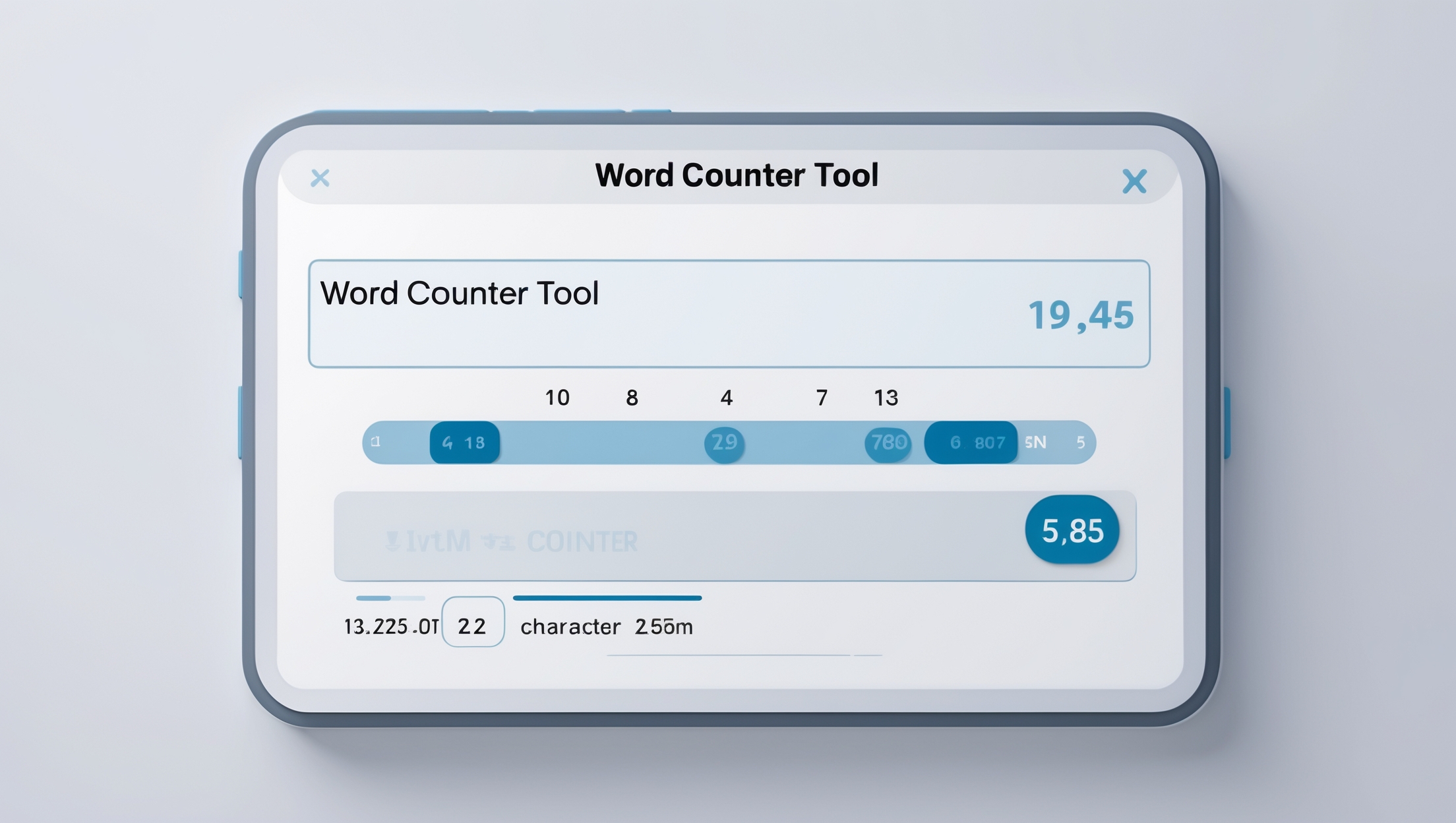Tired of messy code? Our free, online SQL Formatter and XML Formatter instantly transforms unreadable queries and documents into clean, perfectly structured code. Boost your productivity and debug faster—no installation required. Try it now!
You’ve been there. Staring at a monolithic block of SQL code that a colleague sent over. There are no line breaks, no indentation, just a single, intimidating line of text that scrolls endlessly to the right. Your mission, should you choose to accept it, is to understand, debug, or modify it. Your eyes glaze over, your coffee grows cold, and a headache starts to form. This, in a nutshell, is the daily struggle for developers, data analysts, and database administrators everywhere.
In today’s data-driven world, SQL (Structured Query Language) is the backbone of how we interact with databases. But its power is often hidden behind a wall of poorly formatted code. This is where a powerful SQL Formatter becomes not just a convenience, but an absolute necessity.
This comprehensive guide will not only introduce you to the best free, online SQL Formatter and its equally capable companion, the XML Formatter, but will also delve deep into why code formatting is a critical skill for any tech professional. We’ll explore how clean code accelerates development, simplifies debugging, and fosters better team collaboration. Get ready to transform your workflow and say goodbye to chaotic code forever.
Why Your Brain Craves a Good SQL Formatter

Before we jump into the “how,” let’s explore the “why.” Why do we instinctively recoil from a poorly formatted query? It’s about cognitive load—the amount of mental effort required to process information. Unformatted code is cognitively expensive.
Readability Isn’t a Luxury; It’s a Requirement
Think of a well-formatted SQL query like a well-written paragraph. It has structure, rhythm, and clear divisions of thought.
- Keywords (like
SELECT,FROM,WHERE) are aligned. - Clauses are on new lines.
- Subqueries are indented, showing their hierarchical relationship to the main query.
This visual structure allows your brain to quickly parse the logic. You can instantly see the main components of the query, how tables are being joined, what conditions are being applied, and what data is being returned.
Conversely, a minified or poorly formatted query forces your brain to work overtime. You have to manually trace the logic, find the beginning and end of each clause, and mentally reconstruct the structure. According to a study on code readability referenced by experts at a https://www.carnegiescience.edu/” target=”_blank” rel=”noopener noreferrer”>leading scientific institution like Carnegie Science, developers spend significantly more time understanding existing code than writing new code. A SQL Formatter directly attacks this time sink, freeing up valuable mental resources for more complex problem-solving.
The Debugging Nightmare of a Single Line
Trying to find a bug in a single, long line of SQL is like searching for a specific grain of sand on a beach. A missing comma, an extra parenthesis, or a misspelled keyword can be nearly impossible to spot.
When you use a SQL Formatter, these errors often become immediately apparent. The tool attempts to structure the code based on standard SQL syntax. If it can’t, it’s a huge red flag. For instance:
- An unclosed parenthesis will cause all subsequent code to be indented incorrectly.
- A syntax error might break the formatting process entirely.
- The logical flow becomes clear, allowing you to spot flawed
JOINconditions or incorrectWHEREclauses more easily.
In essence, an SQL formatter acts as your first line of defense in the debugging process.
Collaboration and Code Reviews Made Simple
When you work in a team, code is a form of communication. Submitting a perfectly formatted pull request is a sign of professionalism and respect for your colleagues’ time. When everyone on the team uses the same formatting standards—enforced by a tool—it creates a consistent and predictable codebase.
This consistency is invaluable during code reviews. Reviewers can focus on the logic and efficiency of the query rather than getting distracted by stylistic inconsistencies. It eliminates pointless debates about tab size versus space size and ensures the entire project maintains a high standard of quality.
How to Use Our Online SQL Formatter and XML Formatter
We designed our tool with one primary goal: simplicity. We believe a powerful utility shouldn’t require a manual. Here’s how you can go from messy code to beautiful, readable output in seconds.
Step 1: Paste Your Code Copy your unformatted SQL query or XML document and paste it into the left-hand input box, which is clearly marked “Paste your code here…”.
Step 2: Customize Your Formatting (Optional) For those who have specific style guides to follow, our tool offers powerful customization options:
- Indentation Type: Choose between
SpacesorTabs. - Indentation Size: Specify the number of spaces or tabs for each level of indentation (e.g., 2, 4).
- Language Tabs: Easily switch between the SQL Formatter and the XML Formatter with a single click.
Step 3: Click “Format” Press the prominent “Format” button. Instantly, the right-hand output box will display your code, perfectly formatted according to your chosen settings and industry best practices.
Step 4: Copy and Use Your clean code is ready. Use the “Copy to Clipboard” button to grab the formatted output and paste it back into your IDE, database client, or documentation.
It’s that simple. We’ve also included handy features like a “Clear” button to start fresh and a “Dark Mode” switch for those late-night coding sessions.
A Deeper Look: What Makes a Great SQL Formatter?
Not all formatters are created equal. A basic tool might just add line breaks. A truly great SQL formatter, however, understands the nuances of the language.
Understanding SQL Dialects
SQL is a standard, but many database systems have their own “dialect” with unique functions and syntax. This includes:
- T-SQL (Transact-SQL) for Microsoft SQL Server.
- PL/SQL (Procedural Language/SQL) for Oracle.
- MySQL and PostgreSQL specific syntax.
Our SQL formatter is built on a robust engine that recognizes a wide array of keywords and structures across these common dialects. It intelligently handles complex constructs like CASE statements, Common Table Expressions (WITH clauses), and window functions, ensuring they are formatted logically and legibly.
The Logic of Indentation
Proper indentation is the cornerstone of readability. A good formatter doesn’t just indent everything; it indents based on logical hierarchy.
- Main Clauses:
SELECT,FROM,JOIN,WHERE,GROUP BY,HAVING,ORDER BYare kept at the primary indentation level. - Subqueries: Any query nested inside another is indented to show it’s a sub-level component.
- Conditional Logic:
CASE WHEN ... THEN ... ELSE ... ENDblocks are indented to clearly separate the conditions and outcomes. - Parentheses: Code within parentheses is often indented, especially for long lists of columns or values, making them easy to scan vertically.
This intelligent indentation turns a flat wall of text into a multi-dimensional representation of your query’s logic.
Don’t Forget the XML Formatter: Structuring Your Hierarchical Data
While SQL structures relational data, XML (eXtensible Markup Language) is the king of hierarchical data. It’s used everywhere, from configuration files and API responses to legacy systems and document storage. Just like SQL, unformatted XML is a developer’s nightmare.
An XML Formatter (or XML beautifier) is essential for working with this type of data. The https://www.w3.org/XML/” target=”_blank” rel=”noopener noreferrer”>World Wide Web Consortium (W3C) defines the XML specification, and proper formatting is key to visually representing its tree-like structure.
Why You Need an XML Formatter
- Visualizing Hierarchy: Formatted XML clearly shows parent-child relationships between tags through indentation. You can immediately see the entire structure of the document.
- Spotting Errors: Mismatched or unclosed tags are a common source of bugs in XML. A formatter will fail or produce strange output if the XML is not “well-formed,” instantly alerting you to the problem.
- Readability of Attributes: When tags have multiple attributes, a good XML Formatter will place them neatly, making them easy to read without horizontal scrolling.
- API Debugging: When you receive a minified XML response from an API, pasting it into an XML formatter is the fastest way to understand the data structure you’re working with.
Our tool provides a dedicated, high-performance XML Formatter that applies these principles, transforming tangled XML into a clean, navigable tree.
Advanced Use Cases: Go Beyond Simple Formatting
A great developer tool doesn’t just solve one problem; it enhances your entire workflow. Here’s how you can leverage our SQL Formatter and XML Formatter for more than just cleaning up code.
On-the-Fly Learning Tool
For students and junior developers, our formatter is an incredible learning resource. If you’re unsure how to structure a complex query with multiple joins and subqueries, write it out logically but without worrying about the perfect layout. Then, run it through the SQL Formatter. The output will show you the conventional, professional way to structure that query. It’s like having a senior developer guiding your formatting style.
Standardizing Team Code Style
In a team setting, consistency is key. You can establish a “source of truth” for your team’s code style using our tool.
- Agree on the indentation settings (e.g., 4 spaces).
- Mandate that all SQL code checked into your version control system must be run through the formatter with these settings.
This simple rule eliminates stylistic arguments and ensures a uniform, professional look across all your project’s database scripts.
Preparing Code for Documentation and Presentations
When you need to include a code sample in a wiki, a Confluence page, or a PowerPoint presentation, you want it to be as clear as possible. Pasting a formatted query from our tool ensures it’s perfectly indented and easy for your audience to read, even if they aren’t database experts.
Conclusion: Elevate Your Code, Elevate Your Work
In the world of software development and data analysis, time is the most valuable commodity. Every minute spent deciphering a tangled mess of code is a minute not spent building features or deriving insights. A high-quality, reliable SQL Formatter is one of the most effective tools for reclaiming that lost time. It’s a simple utility that pays massive dividends in productivity, code quality, and reduced frustration.
By providing a fast, free, and powerful online SQL Formatter and XML Formatter, we aim to give you back that time. It’s a tool built by developers, for developers, with a deep understanding of the daily challenges you face. Bookmark it, share it with your team, and make it an integral part of your coding toolkit. Stop fighting with your code and start making it work for you.
Frequently Asked Questions (FAQ)
Is an online SQL Formatter safe to use with sensitive data?
This is a critical question. Our tool is designed with privacy as a priority. All formatting is done entirely within your browser using JavaScript. Your code is never sent to our servers. It remains on your machine, ensuring complete confidentiality. However, as a general best practice for any online tool, we always recommend sanitizing or using dummy data if you are working with highly sensitive production information like personal identifiable information (PII).
What’s the difference between a SQL Formatter and a SQL Validator?
A SQL Formatter focuses on the aesthetic presentation and readability of your code (style). It arranges the code according to set rules of indentation and line breaks. A SQL Validator, on the other hand, checks the code against the database’s syntax rules to see if it is executable (substance). While our formatter can help you spot syntax errors visually, its primary job is not to execute or validate the query’s correctness against a live database.
Can this tool format very large SQL files?
Yes. Since the processing happens in your browser, performance depends on your computer’s resources. Our tool is optimized to handle large queries and files efficiently. For exceptionally large files (hundreds of megabytes), a dedicated desktop application might be more suitable, but for the vast majority of day-to-day development tasks, our online formatter is more than powerful enough.
Does the XML Formatter also validate the XML?
Similar to the SQL formatter, the XML Formatter‘s main goal is beautification. It will structure the XML based on its tags. If the XML is not “well-formed” (e.g., has an unclosed tag), the formatting process will likely fail or produce a messy result, which serves as an indirect form of validation. However, it does not validate against a specific DTD or XSD schema.


